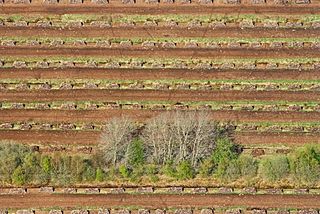
Roslavl is a town and the administrative center of Roslavlsky District in Smolensk Oblast, Russia. It is a road and rail junction and a market town. Population: 54,900 (2010 Census); 57,701 (2002 Census); 60,470 (1989 Census).

Demidov is a town and the administrative center of Demidovsky District in Smolensk Oblast, Russia, located on the Kasplya River at its confluence with the Gobza River. Population: 7,333 (2010 Census); 8,786 (2002 Census); 10,198 (1989 Census). It was previously known as Porechye.

Yelnya is a town and the administrative center of Yelninsky District in Smolensk Oblast, Russia, located on the Desna River, 82 kilometers (51 mi) from Smolensk, the administrative center of the oblast. Population: 10,095 (2010 Census); 10,798 (2002 Census); 9,868 (1989 Census).
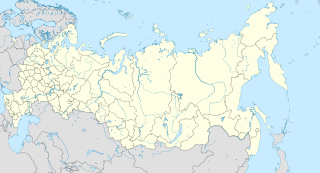
Pochinok is a town and the administrative center of Pochinkovsky District in Smolensk Oblast, Russia, located on the Khmara River 62 kilometers (39 mi) southeast of Smolensk, the administrative center of the oblast. Population: 8,776 (2010 Census); 9,578 (2002 Census); 10,753 (1989 Census).

Krasninsky District is an administrative and municipal district (raion), one of the twenty-five in Smolensk Oblast, Russia. It is located in the west of the oblast and borders with Rudnyansky District in the north, Smolensky District in the east, Monastyrshchinsky District in the south, Horki District of Mogilev Region of Belarus in the southwest, and with Dubrowna District of Vitebsk Region, also of Belarus, in the west. The area of the district is 1,507.67 square kilometers (582.11 sq mi). Its administrative center is the urban locality of Krasny. Population: 12,895 ; 15,537 (2002 Census); 18,758 (1989 Census). The population of Krasny accounts for 33.7% of the district's total population.

Khislavichi is an urban locality and the administrative center of Khislavichsky District of Smolensk Oblast, Russia, located by the right bank of the Sozh River. Population: 4,138 (2010 Census); 4,617 (2002 Census); 5,013 (1989 Census).

Dorogobuzhsky District is an administrative and municipal district (raion), one of the twenty-five in Smolensk Oblast, Russia. It is located in the center of the oblast. The area of the district is 1,771.99 square kilometers (684.17 sq mi). Its administrative center is the town of Dorogobuzh. Population: 29,077 ; 32,672 (2002 Census); 36,016 (1989 Census). The population of Dorogobuzh accounts for 36.9% of the district's total population.

Glinkovsky District is an administrative and municipal district (raion), one of the twenty-five in Smolensk Oblast, Russia. It lies in the center of the oblast and borders with Dorogobuzhsky District in the northeast, Yelninsky District in the southeast, Pochinkovsky District in the southwest, and with Kardymovsky District in the west. The area of the district is 1,225.74 square kilometers (473.26 sq mi). Its administrative center is the rural locality of Glinka. Population: 4,948 ; 6,149 (2002 Census); 7,866 (1989 Census).
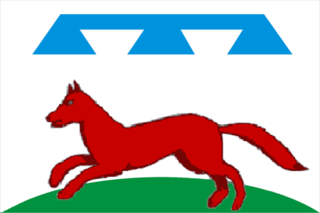
Khislavichsky District is an administrative and municipal district (raion), one of the twenty-five in Smolensk Oblast, Russia. It is located in the southwest of the oblast and borders with Monastyrshchinsky District in the north, Pochinkovsky District in the east, Shumyachsky District in the south, and with Mstsislaw District of Mogilev Region of Belarus in the west. The area of the district is 1,161 square kilometers (448 sq mi). Its administrative center is the urban locality of Khislavichi. Population: 9,070 ; 12,007 (2002 Census); 15,071 (1989 Census). The population of Khislavichi accounts for 45.6% of the district's total population.
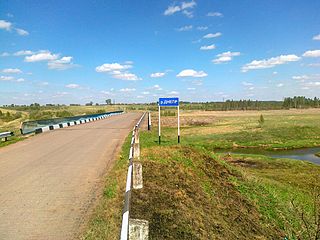
Kholm-Zhirkovsky District is an administrative and municipal district (raion), one of the twenty-five in Smolensk Oblast, Russia. It is located in the north of the oblast. The area of the district is 2,033.40 square kilometers (785.10 sq mi). Its administrative center is the urban locality of Kholm-Zhirkovsky. Population: 10,717 ; 12,815 (2002 Census); 15,966 (1989 Census). The population of the administrative center accounts for 32.6% of the district's total population.

Monastyrshchinsky District is an administrative and municipal district (raion), one of the twenty-five in Smolensk Oblast, Russia. It is located in the west of the oblast and borders with Smolensky District in the north, Pochinkovsky District in the east, Khislavichsky District in the south, Mstsislaw District of Mogilev Region of Belarus in the west, and with Krasninsky District in the northwest. The area of the district is 1,513.75 square kilometers (584.46 sq mi). Its administrative center is the urban locality of Monastyrshchina. Population: 10,788 ; 13,876 (2002 Census); 17,559 (1989 Census). The population of Monastyrshchino accounts for 37.7% of the district's total population.

Pochinkovsky District is an administrative and municipal district (raion), one of the twenty-five in Smolensk Oblast, Russia. It is located in the southern central part of the oblast and borders with Kardymovsky District in the north, Glinkovsky District in the northeast, Yelninsky District in the east, Roslavlsky District in the southeast, Shumyachsky District in the south, Khislavichsky District in the southwest, Monastyrshchinsky District in the west, and with Smolensky District in the northwest. The area of the district is 2,380.75 square kilometers (919.21 sq mi). Its administrative center is the town of Pochinok. Population: 30,959 ; 37,537 (2002 Census); 44,162 (1989 Census). The population of Pochinok accounts for 28.3% of the district's total population.

Roslavlsky District is an administrative and municipal district (raion), one of the twenty-five in Smolensk Oblast, Russia. It is located in the south of the oblast and borders with Yelninsky District in the north, Spas-Demensky District, of Kaluga Oblast, in the northeast, Kuybyshevsky District, also of Kaluga Oblast, in the east, Rognedinsky District of Bryansk Oblast in the southeast, Dubrovsky District, also of Bryansk Oblast, in the south, Yershichsky District in the southwest, Shumyachsky District in the west, and with Pochinkovsky District in the northwest. The territory of the town of Desnogorsk is enclosed from all sides by Roslavlsky District. The area of the district is 3,000 square kilometers (1,200 sq mi). Its administrative center is the town of Roslavl. Population: 76,100 ; 81,307 (2002 Census); 61,000 (1989 Census). The population of Roslavl accounts for 72.1% of the district's total population.

Sychyovsky District is an administrative and municipal district (raion), one of the twenty-five in Smolensk Oblast, Russia. It is located in the northeast of the oblast. The area of the district is 1,803.90 square kilometers (696.49 sq mi). Its administrative center is the town of Sychyovka. Population: 14,158 ; 15,835 (2002 Census); 18,847 (1989 Census). The population of Sychyovka accounts for 57.3% of the district's total population.

Yelninsky District is an administrative and municipal district (raion), one of the twenty-five in Smolensk Oblast, Russia. It is located in the southeast of the oblast and borders with Dorogobuzhsky District in the north, Ugransky District in the east, Spas-Demensky District of Kaluga Oblast in the southeast, Roslavlsky District in the south, Pochinkovsky District in the west, and with Glinkovsky District in the northwest. The area of the district is 1,808.15 square kilometers (698.13 sq mi). Its administrative center is the town of Yelnya. Population: 14,948 ; 17,457 (2002 Census); 19,699 (1989 Census). The population of Yelnya accounts for 67.5% of the district's total population.
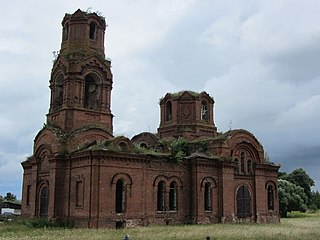
Yershichsky District is an administrative and municipal district (raion), one of the twenty-five in Smolensk Oblast, Russia. It is located in the south of the oblast and borders with Roslavlsky District in the north, Dubrovsky District of Bryansk Oblast in the east, Kletnyansky District, also of Bryansk Oblast, in the south, Khotsimsk District of Mogilev Region of Belarus in the southwest, Klimavichy District of Mogilev Region in the west, and with Shumyachsky District in the northwest. The area of the district is 1,039.00 square kilometers (401.16 sq mi). Its administrative center is the rural locality of Yershichi. Population: 7,102 ; 8,859 (2002 Census); 11,544 (1989 Census). The population of Yershichi accounts for 44.6% of the district's total population.

Golynki is an urban-type settlement in Rudnyansky District of Smolensk Oblast, Russia. It is located on the banks of the Yelenka River. Population: 3,573 (2010 Census); 3,884 (2002 Census); 4,607 (1989 Census).

Monastyrshchina is an urban locality and the administrative center of Monastyrshchinsky District of Smolensk Oblast, Russia. It is located on the left bank of the Vikhra River, in the western part of the oblast. Population: 4,065 (2010 Census); 4,622 (2002 Census); 5,166 (1989 Census).

Shumyachi is an urban locality and the administrative center of Shumyachsky District of Smolensk Oblast, Russia. Population: 4,227 (2010 Census); 4,731 (2002 Census); 5,724 (1989 Census).

Yershichi is a rural locality and the administrative center of Yershichsky District of Smolensk Oblast, Russia. It is located on the right bank of the Iput River. Population: 3,169 (2010 Census); 3,326 (2002 Census); 3,808 (1989 Census).










